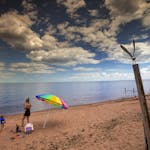The U.S. Supreme Court on Thursday eliminated federal protections for vast numbers of the nation's wetlands, setting the stage for their conversion to farm fields and urban development.
The effect could be blunted for Minnesota's 10 million acres of wetlands because of state conservation laws. But the effects of lost wetlands elsewhere could be felt here in the impact on migratory birds and water quality.
The nation's highest court ruled that federal Clean Water Act protections only apply to wetlands with a "continuous surface connection" to bodies of water already deemed waters of the United States. That means more isolated wetlands will no longer be protected, and parties seeking to dredge or fill them would no longer be required to get a permit from the Army Corps of Engineers.
Industry groups say they have long sought clarity on what sets a wetland apart. The National Corn Growers Association applauded the ruling as "a huge win to landowners." Warren Formo, executive director of the Minnesota Agricultural Water Resource Center, said he welcomes the narrowed definition because permitting is a long, expensive process for land managers.
Environmental groups called it an egregious rollback that could endanger up to half of the country's wetlands.
"It's terrible. Its disappointing. It blows a big hole in the side of the Clean Water Act and unfortunately it's also not surprising," said Janette Brimmer, senior attorney at the nonprofit environmental law firm Earthjustice, which represented 18 Native American tribes in the case, including the that Fond du Lac Band of Lake Superior Chippewa and the Grand Portage Band of Lake Superior Chippewa. "It's divorced entirely from the science of hydrology and how wetlands work."
Brimmer estimated that about 90 million acres of U.S. wetlands will lose federal protections.
Minnesota has extensive statutory protections for its vast expanse of bogs, swamps, sloughs, marshes and fens that remain in force.
"It really will have very minor impact in Minnesota," said John Jaschke, executive director of the Board of Water and Soil Resources, the state's top wetland regulator.
The state defines protected wetlands very broadly, including areas where the soil is saturated but there's no standing water.
Minnesota's wetland protections have been in statute since the 1970s and were greatly expanded by the 1991 Minnesota Wetland Conservation Act. The act aims for no net loss of wetlands, and prohibits draining or filling wetlands without replacing them with wetlands of equal value elsewhere, which could mean buying wetland banking credits to preserve other wetlands nearby.
Jaschke said the agency doesn't know how many of the state's wetlands are losing federal protections, and it probably will never need to find out. But he thinks most of them would be in the western and southern part of the state that is pocked by shallow and more isolated prairie potholes. The state's northeast has more interconnected bogs, he noted.
The Supreme Court case, Sackett v. Environmental Protection Agency, developed after Mike and Chantell Sackett filled in a wet area in 2004 to build a home on Priest Lake in Idaho. The EPA said the Sacketts couldn't build on the lot without a permit because of the federally protected wetland.
The ruling was 5-4, with Justice Brett Kavanaugh joining the three liberal justices opposing the majority's broad interpretation of the law.
The Supreme Court ruling is at odds with a final rule from the EPA and the U.S. Department of the Army. In December the two agencies defined federally protected "waters of the United States" to include wetlands with a "significant nexus" to lakes, streams and tributaries — meaning they affect their biological, physical or chemical makeup even if they don't appear on the surface to be connected.
EPA Administrator Michael Regan issued a statement Thursday saying he was "disappointed" in the ruling and that it "erodes longstanding clean water protections." The agency is considering its next steps, he said.
The Minnesota Pollution Control Agency said it is reviewing the decision to determine whether it affects its programs.
In an interview, Barb Naramore, deputy commissioner of the state Department of Natural Resources, said she's concerned the ruling could affect the health of waterfowl and migrating birds in the state. The Mississippi River is a critical flyway for birds, and while Minnesota doesn't rely heavily on federal wetlands protections, other states do. Weakened protections could degrade crucial wetlands along the migration corridor.
"To the extent that the federal government is less involved in regulating many types of wetlands, that may well have implications for wildlife populations that people see in Minnesota and the health of those populations," Naramore said.
John Rumpler, clean water director for the nonprofit Environment Minnesota, called the ruling an "incorrect reading" of one of the country's bedrock environmental laws.
"The only place to go is back to Congress," Rumpler said.




